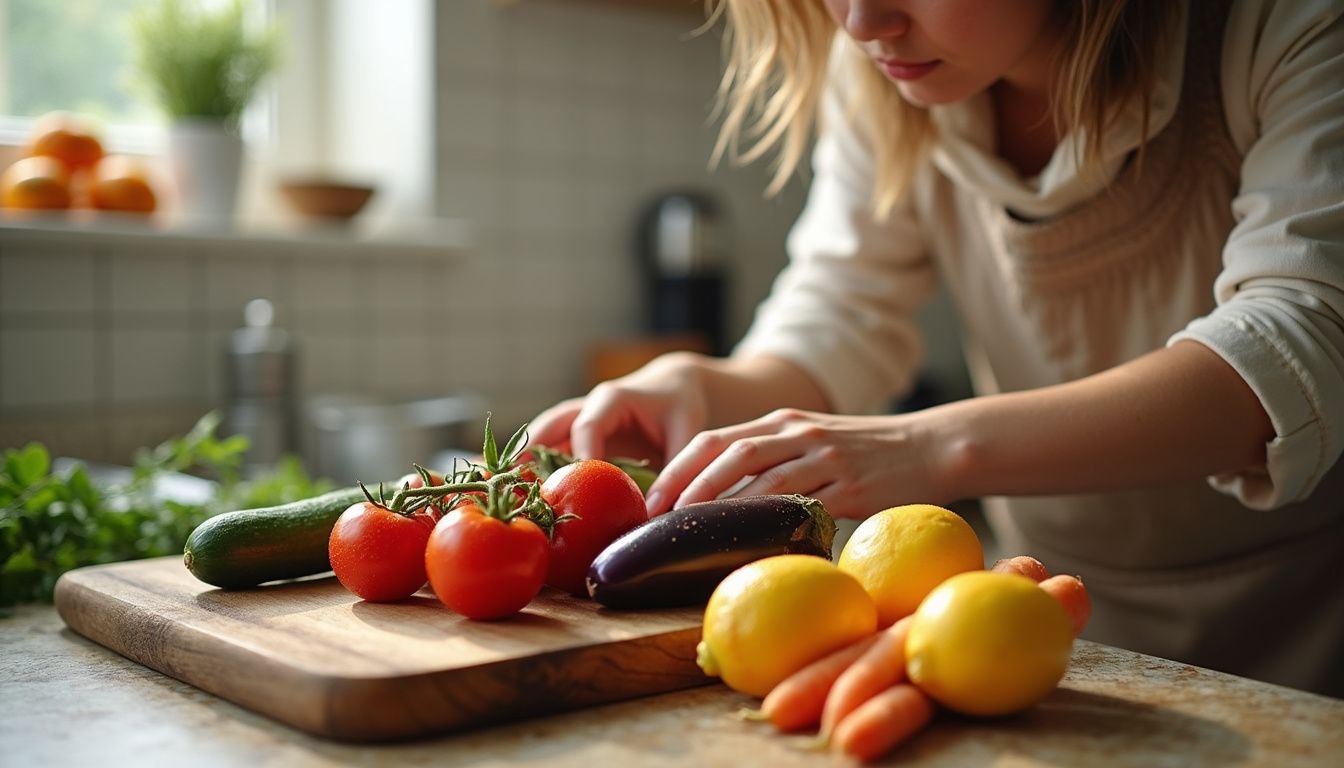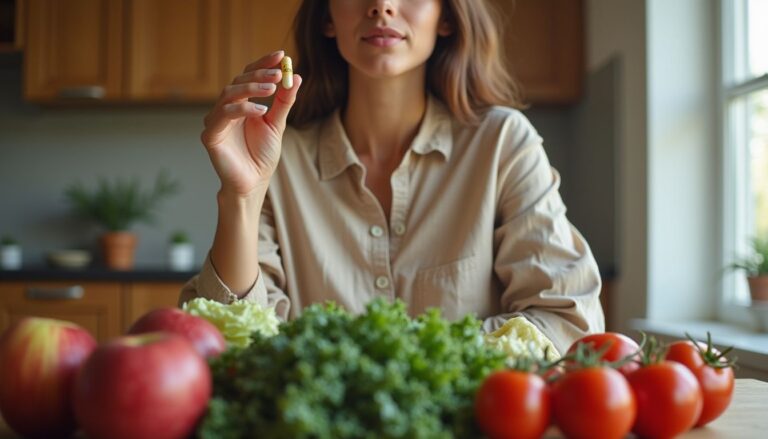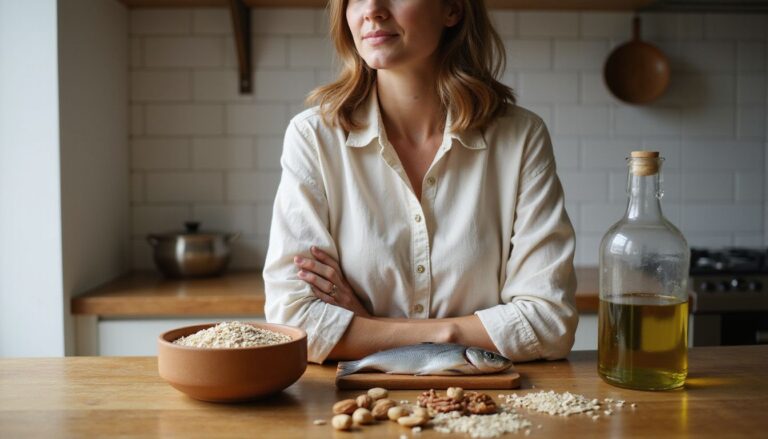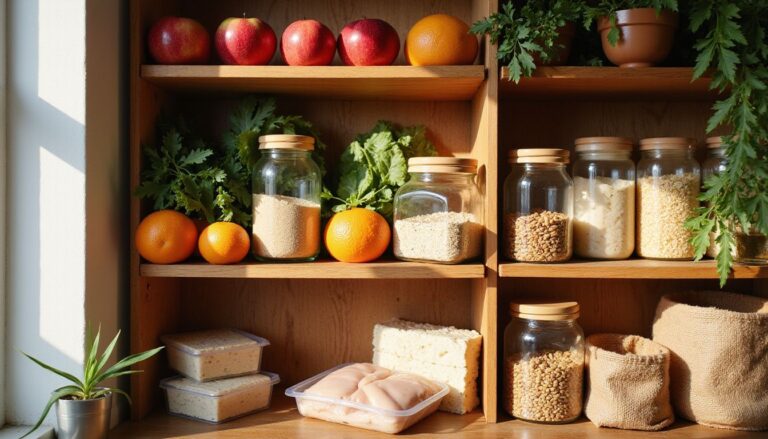Delicious Low Calorie Snacks: Healthy Options Under 100 Calories
Our Nutrition Assistant AI Suite will transform your body. You will lose fat, get toned, and build muscle. Gain confidence and optimal health.
Finding a healthy snack that curbs hunger without extra calories can feel tricky. I aim for a low calorie snack that stays near 100 calories, tastes good, and travels well. With a few smart picks, I can snack without stalling my goals.
Choosing foods rich in protein, fiber, or vitamins helps manage cravings and steadies energy. This guide offers simple snack ideas with clear nutrition facts, so picking better options feels easy, not stressful.
These snacks fit a busy life and deliver real flavor. Keep reading for fast, tasty ways to snack smarter.
Key Takeaways
- Snacks with 100 calories or less, like nonfat Greek yogurt at 84 calories per half cup, can help with weight control by limiting extra calorie intake.
- Whole foods such as fruit, vegetables, and nuts supply fiber, vitamins, antioxidants, and protein, key nutrients that help you feel full while keeping saturated fat low.
- Pairing protein and carbs, for example hard-boiled eggs with almonds or hummus with carrots, supports steady blood sugar and more stable energy.
- Pre-portioning snacks and reading Nutrition Facts labels can keep sodium below 250 milligrams and reduce added sugar.
- USDA findings from 2022 highlight nutrient-dense picks like edamame, roasted chickpeas, and sunflower seeds as heart-friendly choices within a balanced eating plan.

Benefits of Choosing Low-Calorie Snacks
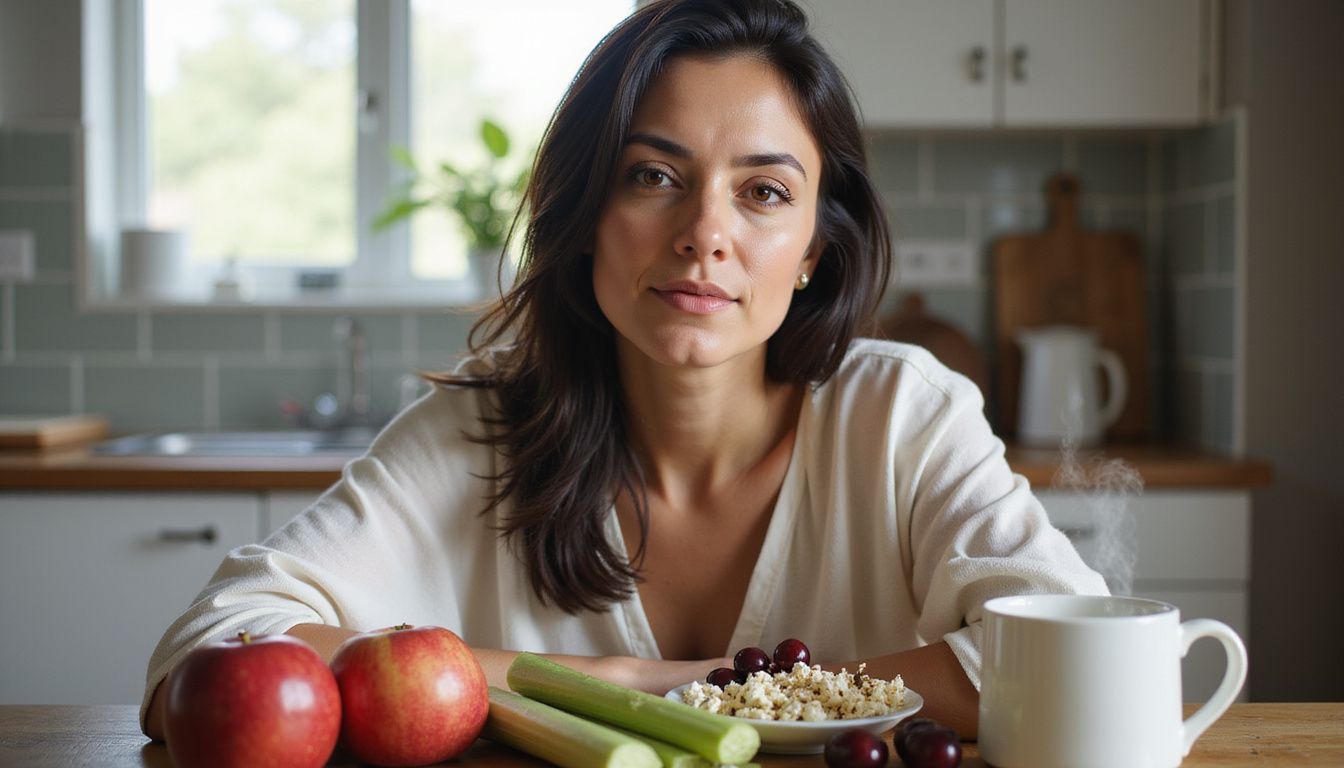
Low-calorie snacks help me manage daily calories while still enjoying food. Simple choices add up across the week, which supports healthy eating and long-term goals.
How Do Low-Calorie Snacks Help with Weight Management?
Keeping snacks at 100 calories or less prevents oversized portions and extra grazing. I pre-portion items into small containers or bags, which stops mindless eating and helps me hit my calorie targets.
Fruit and vegetables provide fiber and water, both of which support fullness more than highly processed treats. CDC guidance notes that low-calorie produce like carrots, apples, and nonfat Greek yogurt can support a healthy weight, in part because they increase satiety and may reduce overeating at meals.
Checking the Nutrition Facts panel keeps each serving near 100 calories and ensures I still get vitamins and minerals that support a balanced plate.
Can Low-Calorie Snacks Boost Your Energy?
Nutrient-dense picks like apple slices or a cup of mixed berries give steady energy without sugar spikes. I stay more alert in the afternoon when I include fiber and plant protein, such as edamame or chickpeas.
Combining carbs with a little protein or fat, for example whole-grain crackers with hummus, helps stabilize blood glucose. After exercise, protein-rich snacks like cottage cheese or nonfat Greek yogurt support muscle recovery and reduce crashes that follow sugary treats.
Drinking water with snacks further supports hydration and focus. For busy school or work days, options under 100 calories keep me fueled without feeling weighed down.
How Do Low-Calorie Snacks Support a Balanced Diet?
Fresh produce and whole grains add vitamins, minerals, fiber, and antioxidants without many calories. For instance, apples or bell peppers bring vitamin C and fiber, and each serving can fit under 100 calories.
Protein choices like nonfat Greek yogurt or roasted chickpeas help me stay full between meals. I often pair food groups, such as berries with strained yogurt or carrots with bean dip, to boost variety and nutrients.
Choosing foods low in added sugar and saturated fat supports heart health. Whole foods keep snacks satisfying without the empty calories seen in many cookies or chips.
Source note: The CDC and USDA provide guidance on calorie control, nutrient density, and healthy eating patterns cited here.
Tips for Selecting Healthy Snacks
I reach for whole foods like fruit, vegetables, and nuts, since they are simple, filling, and easy to portion. Picking snacks high in protein or fiber keeps me full longer and supports my diet goals.
Why Choose Whole, Unprocessed Ingredients?
Fresh produce such as cherry tomatoes, cantaloupe, and bell pepper strips delivers vitamins, minerals, antioxidants, fiber, and some protein with no added sugar or oil. Whole foods pack more nutrients per bite and usually fewer calories. They help me feel satisfied longer than snacks made with refined flour.
A cup of fresh or frozen berries stays under 100 calories yet provides fiber and antioxidants. Whole-grain crackers also beat white flour versions for nutrition. Prepping ingredients ahead of time makes healthy choices more likely on busy days.
Swapping packaged cookies for apple slices supports my heart and overall health. More unprocessed foods can reduce chronic disease risk and make a balanced diet easier to maintain.
What Are High-Protein and Fiber-Rich Snack Options?
Protein and fiber team up to curb hunger and steady energy. I rely on quick picks I can portion in seconds.
- Almonds, about 14 pieces, around 100 calories with minimal saturated fat.
- Edamame, 1/3 to 1/2 cup, about 8 grams of protein and 4 grams of fiber near 100 calories.
- One hard-boiled egg with a few almonds, a filling mix under 100 calories.
- Air-popped popcorn, 6 cups for roughly 100 calories and 6 grams of fiber.
- Roasted chickpeas, portioned with a measuring cup to control calories and add legume fiber.
- Nonfat Greek yogurt, half cup plain with a touch of honey, about 84 calories and 12 grams of protein.
- Small homemade trail mix with nuts, seeds, and a little dried fruit, measured for calorie control and omega-3s from seeds like sunflower.
Each choice helps me feel satisfied longer and supports better habits between meals.
How Can You Avoid Added Sugars and Fats?
I skip sweetened cereals and use one third cup of plain oat squares, just 70 calories and very low in saturated fat. For yogurt, I pick nonfat plain and add banana or berries for sweetness, not sugar-laden flavors.
To limit unhealthy fats, I choose unsalted nuts, seeds, bean dips, or low-fat cottage cheese. I pass on most 100-calorie cookie packs, since many are low in protein and fiber but high in added sugar.
Fresh or frozen fruit satisfies a sweet tooth without syrups. I also avoid processed meats and full-fat cheeses for snacks to keep cholesterol and saturated fat in check while staying under 100 calories.
Popular Fruits Under 100 Calories
Fruits like apple slices, mixed berries, grapes, and oranges bring bright flavor for less than 100 calories per serving. These are easy wins for diet snacks during a busy day.
Are Apple Slices a Good Low-Calorie Snack?
Apple slices are quick, sweet, and high in fiber. Three quarters of a cup of apple slices with up to 2 teaspoons of unsalted peanut butter lands near 90 calories with low saturated fat and very little sodium.
Apples deliver vitamin C and antioxidants that fit a healthy diet. The nut butter adds protein and a creamy texture while staying under the 100 calorie cap per serving.
Some people also use apple slices in simple baking swaps to cut calories. Mixed berries bring similar benefits with a different flavor profile.
What Makes Mixed Berries a Healthy Choice?
Mixed berries pack nutrients and flavor with very few calories. One cup stays below 100 calories, which fits my goal of eating low-calorie snacks.
Berries provide vitamin C, fiber, and antioxidants that support immune and heart health. They have almost no saturated fat and very little sodium, which makes them heart-friendly.
I keep a cup of frozen mixed berries ready for a fast snack, or I toss them into plain yogurt or a smoothie with nonfat milk. For example, blending one third cup of nonfat yogurt with two thirds cup of frozen blueberries plus ice makes a smooth, low-calorie treat.
Six ounces of Greek yogurt topped with half a cup of berries adds protein and calcium while keeping calories in check. On hot days, frozen berries alone feel like dessert without the added sugar.
How Many Grapes Can You Eat for Under 100 Calories?
One cup of grapes fits under 100 calories and offers vitamin K, manganese, and fiber. Saturated fat is almost zero with no cholesterol and very low sodium.
I portion grapes by the cup so I do not overeat. They are refreshing fresh or frozen and feel like a cool treat without added sugar.
Pair one cup of grapes with a piece of string cheese if I want a bit of protein while keeping the total near 100 calories.
Is an Orange a Filling Low-Calorie Snack?
One medium orange has about 62 calories. It brings vitamin C, water, and fiber that support immunity, digestion, and hydration.
I find an orange very filling thanks to its fiber. Sometimes I pair slices with 1 tablespoon of nut butter or a small piece of mozzarella to make a balanced snack that stays under 100 calories.
Dietitians often recommend oranges for energy and hydration in a low-calorie eating plan.
Vegetables Perfect for Snacking
I keep crisp vegetables ready because they are low in calories and high in nutrients. A pinch of black pepper or a light drizzle of olive oil can add flavor without many calories.
Why Snack on Carrot Sticks?
Carrot sticks give crunch at a tiny calorie cost. Eight baby carrots with 2 tablespoons of hummus land near 100 calories, with very little saturated fat and moderate sodium.
Carrots are low in fat, have no cholesterol, and are rich in vitamin A for vision and immune support. Fiber helps me feel full, which can aid with weight control.
I slice carrots ahead for grab-and-go freshness. The texture slows my eating, which beats the speed of munching on chips.
Pairing carrots with protein-rich dips like hummus boosts fullness without the heavy fats found in fried snacks. For anyone seeking nutritious bites under 100 calories, carrots are an easy, budget-friendly pick.
Are Cucumber Slices a Healthy Snack Option?
Cucumber slices are a hydrating, low-calorie choice. One cup has about 16 calories, is fat-free, and is low in sodium. They also provide vitamin K for bone health and are more than 95 percent water.
I top cucumber rounds with salsa for a tangy bite or pair them with light tuna for extra protein. Eating them raw avoids added sugars and oils from processed snacks.
Cherry tomatoes are another easy vegetable I keep handy when I want variety.
What Are the Benefits of Cherry Tomatoes as a Snack?
Cherry tomatoes are low in calories and high in nutrients. One cup has under 30 calories with vitamin C and lycopene, a plant compound linked to heart health. They contain no cholesterol.
I pack them for work or school because they need no prep. Sometimes I add string cheese or cottage cheese on a rice cake for more protein while staying near 100 calories.
They add color and umami taste to crackers or salads without many calories. If I want more crunch, I switch to bell pepper strips next.
How to Enjoy Bell Pepper Strips as a Snack?
Bell pepper strips are crisp, sweet, and hydrating. I prep them in batches so they are ready whenever I need a quick bite.
- Slice fresh bell peppers into thin strips for grab-and-go convenience.
- Pair with 1 tablespoon of hummus or black bean dip for protein and flavor.
- Choose red, yellow, or orange peppers. Each is rich in vitamin A and C and has fewer than 30 calories per cup.
- Store strips in airtight containers to keep them crisp all week.
- Mix with carrot sticks or cucumber slices for a filling snack that stays under 100 calories.
- Add a light sprinkle of chili powder or cinnamon for extra flavor without added sugar.
- Peppers are naturally low in sodium and fat, which supports weight goals and steady energy.
- Pair with a few whole-grain crackers for a balanced mini-meal under 100 calories.
Prepping ahead makes it easier for me to choose peppers instead of chips or sweets.
Low-Calorie Dairy Snack Options
Dairy can deliver protein and calcium without many calories. I lean on these options because they keep me full longer than sugary snacks.
How Healthy Is Nonfat Greek Yogurt as a Snack?
Nonfat Greek yogurt is a high-protein choice that fits under 100 calories. Half a cup with a teaspoon of honey has about 84 calories with no saturated fat and around 54 milligrams of sodium.
That serving gives roughly 12 grams of protein, which helps me stay full. I choose plain yogurt to avoid added sugar in many flavored cups.
Six ounces of plain yogurt with a half cup of berries and a light sprinkle of granola keeps me near 100 calories while adding fiber. Nonfat choices usually come lower in both calories and fat than regular versions, which supports weight goals.
Cottage cheese with herbs is another savory option when I want variety.
Can Cottage Cheese with Herbs Be a Low-Calorie Snack?
After Greek yogurt, I often choose cottage cheese with herbs. Half a cup has about 100 calories, around 0.7 grams of saturated fat, and about 14 grams of protein.
Fresh herbs like dill or basil add flavor without raising calories. I also pair cottage cheese with cantaloupe for steady energy on busy afternoons.
Two tablespoons layered on a rice cake and topped with cherry tomatoes and basil stays under 100 calories. For convenience and protein, cottage cheese checks all the boxes.
Protein-Packed Snacks Under 100 Calories
Protein can help you feel full and support muscle health. I rotate between eggs, legumes, fish, and seeds to keep things interesting without blowing my calorie budget.
Are Hard-Boiled Eggs a Good Low-Calorie Snack?
One hard-boiled egg has about 70 calories and supplies high-quality protein. It keeps me satisfied for hours, which curbs random snacking.
Eggs bring vitamin B12, riboflavin, and selenium. I often pair one egg with 12 almonds to stay under 100 calories while adding healthy fats.
I prepare several eggs at once for fast snacks. For a twist, I stir yogurt with curry powder, garlic powder, and lemon juice, then coat sliced eggs for bold flavor without many calories.
Turkey slices or sunflower seeds also add variety when I want more protein choices under 100 calories.
Why Try Edamame as a Snack?
Edamame is a smart pick for plant-based protein. A half cup is about 100 calories with less than 1 gram of saturated fat and more than 8 grams of protein.
It is low in sodium and provides iron, which supports energy and immunity. I boil a handful of pods and season with chili flakes for a spicy snack that stays under 100 calories.
Each serving gives around 4 grams of fiber plus protein, so it keeps me full between meals.
How to Enjoy Roasted Chickpeas for Protein?
I roast 400 grams of chickpeas with one teaspoon oil, one teaspoon paprika, two teaspoons cumin, and two teaspoons coriander for crunch and flavor. Roasted chickpeas deliver protein, fiber, and less than 2 grams of saturated fat per small serving.
A modest handful offers about 5 to 6 grams of protein and stays under 100 calories. I switch seasonings, from Mediterranean herbs to a spicy blend, to keep things fresh.
Chickpeas are naturally cholesterol-free and support heart health in studies cited by the USDA in 2022. They work on salads or as a portable snack.
Is Light Tuna on Cucumber Slices a Healthy Snack?
Light tuna on cucumber rounds is lean, fast, and fresh. Half a can of drained light tuna has about 45 calories and roughly 10 grams of protein.
Six thick cucumber slices add fewer than 15 calories and extra hydration. Tuna is low in saturated fat and cholesterol, which supports heart health.
This combo takes minutes to assemble and holds well for meal prep. Tuna supplies vitamin D and selenium, while cucumbers add crunch without added sugar or fat.
Whole-Grain Snack Choices Under 100 Calories
Whole-grain snacks bring fiber for fullness and steady energy. I keep a few go-to options to cover sweet and savory moods.
What Makes Air-Popped Popcorn a Good Snack?
Air-popped popcorn is crunchy and filling with very few calories. Six cups have around 100 calories with roughly 0.5 grams of saturated fat and about 220 milligrams of sodium.
That serving delivers about 6 grams of fiber, which helps with fullness. I often make three cups and add 2 tablespoons of shredded parmesan to stay under 100 calories with more flavor.
This whole-grain pick supplies carbs with little fat compared to oil-popped versions. A dusting of cinnamon gives a hint of sweetness without added sugar.
Are Whole-Grain Crackers Healthy Snack Options?
Three whole-grain crackers with a small slice of cheese land around 100 calories. That combo includes roughly 1.2 grams of saturated fat, 397 milligrams of sodium, and 7 milligrams of cholesterol.
Five whole wheat crackers with one ounce of cheddar sit near the same calorie mark. I prefer high-fiber crackers for lasting energy and better digestive health.
I avoid sweetened or highly processed varieties. A thin whole-grain flatbread with a light smear of almond butter and fruit preserves can also fit under 100 calories if I measure carefully.
For more crunch, I often top rice cakes with avocado or hummus.
How to Top Rice Cakes with Avocado or Hummus?
Rice cakes are a simple whole-grain base for low-calorie snacks. Avocado and hummus add flavor, healthy fats, and protein while staying within my calorie goal.
- Pick plain rice cakes made from whole grains, about 35 to 40 calories each.
- Spread 1 tablespoon mashed avocado, about 25 calories, for a creamy texture.
- On another cake, add 1 tablespoon hummus, about 30 to 35 calories, for savory flavor and protein.
- Use fresh herbs like basil or dill to lift flavor without calories.
- Add tomato slices, cucumber rounds, or bell pepper strips for crunch.
- Try cottage cheese with six cherry tomatoes and chopped basil for about 80 to 90 calories per cake.
- Keep each version under 100 calories by measuring spreads and skipping high-fat extras like mayo.
- Gluten-free rice cakes work well if needed and usually stay low in calories.
These ideas leave room for dairy or fruit snacks later in the day.
Quick Snacks with Nuts and Seeds
Nuts and seeds are small but mighty. They offer protein, healthy fats, and key vitamins that keep me satisfied between meals for fewer than 100 calories when I portion them.
Why Are Almonds a Smart Low-Calorie Snack?
Fourteen almonds equal about 100 calories with around 0.63 grams of saturated fat and zero sodium or cholesterol. They bring protein and healthy fats that help control hunger.
A small handful adds vitamin E, magnesium, and fiber. I sometimes pair 12 almonds with a medium apple or pear for a balanced 100 calorie snack.
Next up, sunflower seeds add crunch and nutrients in tiny portions.
What Nutrients Do Sunflower Seeds Provide?
Sunflower seeds offer healthy fats, vitamin E, and magnesium. One teaspoon has about 0.26 grams of saturated fat and zero sodium, which supports heart health.
They are naturally cholesterol-free. I sprinkle a measured spoonful over salads or stir into half a cup of nonfat yogurt for a snack under 100 calories.
Because seeds are energy-dense, portion control matters. A measured serving adds crunch plus minerals and antioxidants.
Creative Ideas for Low-Calorie Snacks
With a few swaps and a little prep, I can build low calorie snacks that satisfy cravings and stay within my calorie limit.
How to Make Apple Slices with Cinnamon?
I thinly slice a fresh apple, then dust the pieces with ground cinnamon. The spice adds warmth and sweetness without sugar. It also supplies antioxidants, natural compounds that protect cells from damage.
One small apple with cinnamon has fewer than 80 calories with almost no fat or sodium. It is a simple, budget-friendly snack that fits under 100 calories and supports steady blood sugar.
What Are Cucumber Rounds Topped with Salsa?
For a savory pick, I cut thick cucumber rounds and spoon on salsa. This combo is low in calories and fat-free, yet full of flavor.
It is gluten-free and vegan, so it fits many diets. Even 1 cup of jicama sticks with salsa is only about 54 calories with minimal saturated fat and modest sodium.
Prepping a container of cucumber and salsa at the start of the week makes snacking easy and refreshing under 100 calories.
Why Choose Frozen Berries or Grapes for Refreshment?
Frozen berries and grapes turn into a cool, crisp snack that feels like a treat. One cup of frozen grapes has fewer than 100 calories with almost no saturated fat or sodium.
Freezing preserves nutrients and creates a satisfying texture. Three quarters of a cup of frozen mango cubes gives about 90 calories and provides more than half a day’s vitamin C for many people.
I also blend frozen berries into smoothies or spread them on yogurt bark for extra variety under 100 calories.
Combining Snacks for Better Flavor and Nutrition
Combining snacks can improve taste and nutrition at the same time. I mix textures and food groups to keep calories low yet satisfaction high.
How to Mix Greek Yogurt with Fresh Fruit?
I spoon 6 ounces of plain Greek yogurt into a bowl for a high-protein base at about 100 calories. Then I add half a cup of mixed berries for fiber, antioxidants, and natural sweetness.
A small sprinkle of granola adds crunch while keeping calories near 100. For a lighter twist, I mix half a cup of nonfat Greek yogurt with 1 teaspoon of honey for about 84 calories and around 12 grams of protein.
Layering yogurt and fruit as a parfait keeps me full and adds calcium, protein, and vitamins.
What Are Good Veggie and Hummus Pairings?
Carrot sticks with hummus are a classic pair. Eight baby carrots with 2 tablespoons of hummus total about 100 calories.
Cucumber slices and bell peppers also work well. I sometimes dip cherry tomatoes into beet hummus made from chickpeas, roasted beet, olive oil, lemon juice, and black pepper for color and flavor.
A cup of raw vegetables with either 2 tablespoons of black bean dip or one quarter cup of hummus stays near 100 calories and supplies fiber, protein, and healthy fats. This combination keeps me satisfied longer.
How to Combine Nuts with Dried Fruit?
I make trail mix with a quarter cup total to stay under 100 calories. I combine walnuts with dried cranberries or raisins for protein, fiber, and healthy fats.
Three or four dark chocolate chips can add flavor without pushing calories too high. Since nuts and dried fruit are calorie dense, I always measure instead of scooping by hand.
Trail mix is portable and customizable. Hard-boiled eggs are another quick protein option when I want a change.
Conclusion
Healthy snacking can be simple and satisfying. Keeping a few low-calorie staples ready helps me choose a healthy snack fast, stick near 100 calories, and avoid added sugar or extra salt.
Fruit, yogurt, vegetables, hummus, cottage cheese, and edamame give protein, fiber, and key vitamins in small portions. With a little planning and portion control, I can enjoy flavor and stay on track with my goals. This article offers general tips. If you have medical concerns, talk with a registered dietitian or your healthcare provider.
FAQs
1. What are some healthy snacks under 100 calories that taste good?
Many nutritious options fit this category, such as Greek yogurt with berries, air-popped popcorn, or a small apple with nut butter. For example, one cup of strawberries contains about 50 calories and provides vitamin C and fiber according to the USDA FoodData Central.
2. How can I make sure my low calorie snack is filling?
Choose foods high in protein or fiber like cottage cheese or carrot sticks paired with hummus. Research from Harvard School of Public Health shows that protein and fiber help increase satiety, making you feel full longer even when eating fewer calories.
3. Are packaged low calorie snacks as healthy as fresh options?
Packaged items may contain added sugars or sodium not found in whole foods like fruit slices or raw vegetables. A study published in Nutrients journal highlights that minimally processed choices often offer more vitamins and minerals per serving compared to most pre-packaged alternatives.
4. Can I eat several low calorie snacks throughout the day instead of large meals?
Eating smaller portions more frequently can help manage hunger if each choice is nutrient-dense and balanced. In my experience tracking food intake for weight management, spreading out healthy snacks such as sliced cucumbers or hard-boiled eggs helped maintain steady energy levels without exceeding daily caloric goals.
Summary: Healthy snacking under 100 calories involves selecting nutrient-rich foods like fruits, vegetables, dairy products, and lean proteins while limiting processed ingredients for better overall nutrition and satisfaction.

